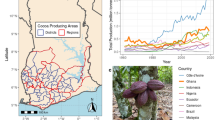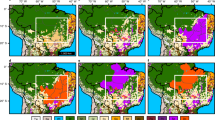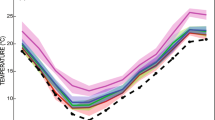Abstract
The North China Plain (NCP) is one of the most important agricultural regions in Asia and produces up to 50% of the cereal consumed in China each year1,2. To meet increasing food demands without expanding croplands, annual agricultural practice in much of the NCP has changed from single to double cropping3,4. The impact of double cropping on the regional climate, through biophysical feedbacks caused by changes in land surface conditions, remains largely unknown. Here we show that observed surface air temperatures during the inter-cropping season (June and July) are 0.40 °C higher over double cropping regions (DCRs) than over single cropping regions (SCRs), with increases in the daily maximum temperature as large as 1.02 °C. Using regional climate modelling, we attribute the higher temperatures in DCRs to reduced evapotranspiration during the inter-cropping period. The higher surface temperatures in June and July affect low-level circulation and, in turn, rainfall associated with the East Asian monsoon over the NCP and neighbouring countries. These findings suggest that double cropping in the NCP can amplify the magnitude of summertime climate changes over East Asia.
This is a preview of subscription content, access via your institution
Access options
Subscribe to this journal
Receive 12 print issues and online access
$209.00 per year
only $17.42 per issue
Buy this article
- Purchase on Springer Link
- Instant access to full article PDF
Prices may be subject to local taxes which are calculated during checkout




Similar content being viewed by others
References
Godfray, H. C. J. et al. Food security: The challenge of feeding 9 billion people. Science 327, 812–818 (2010).
Piao, S. L. et al. The impacts of climate change on water resources and agriculture in China. Nature 467, 43–51 (2010).
Cook, R. J. Toward cropping system that enhance productivity and sustainability. Proc. Natl Acad. Sci. USA 103, 18389–18394 (2006).
Liu, Y., Wang, E. L., Yang, X. G. & Wang, J. Contributions of climatic and crop varietal changes to crop production in the North China Plain, since the 1980s. Glob. Change Biol. 16, 2287–2299 (2010).
Ramankutty, N. & Foley, J. A. Estimating historical changes in global land cover: Croplands from 1700 to 1992. Glob. Biogeochem. Cycles 13, 997–1027 (1999).
Xu, Z. et al. Grain for green versus grain: Conflict between food security and conservation set aside in China. World Dev. 34, 130–148 (2006).
Rudel, T. K. et al. Agricultural intensification and changes in cultivated areas, 1970–2005. Proc. Natl Acad. Sci. USA 106, 20675–20680 (2009).
National Bureau of Statistics of China, China Statistical Year Book 1995–2010 (China Statistics Press, 2010).
Ho, C. H., Park, S. J., Jeong, S. J., Kim, J. & Jhun, J. G. Observational evidences of double cropping impacts on the climate in the northern China plains. J. Clim. 25, 4721–4728 (2012).
Gong, D. Y. & Ho, C. H. Shift in the summer rainfall over the Yangtze River valley in the late 1970s. Geophys. Res. Lett. 29, 1436 (2002).
Bonan, G. B. Observational evidence for reduction of daily maximum temperature by croplands in the Midwest United States. J. Clim. 14, 2430–2442 (2001).
Jeong, S. J., Ho, C. H. & Jeong, J. H. Increase in vegetation greenness and decrease in springtime warming over East Asia. Geophys. Res. Lett. 36, L02710 (2009).
Pielke, R. A. et al. Interactions between the atmosphere and terrestrial ecosystems: Influence on weather and climate. Glob. Change Biol. 4, 461–475 (1998).
Xue, Y. et al. Role of land surface processes in monsoon development: East Asia and West Africa. J. Geophys. Res. 109, D03105 (2004)
Wang, B., Jhun, J. G. & Moon, B. K. Variability and singularity of Seoul, South Korea, rainy season (1778–2004). J. Clim. 20, 2572–2580 (2007).
Koster, R. D. et al. Regions of strong coupling between soil moisture and precipitation. Science 305, 1138–1140 (2004).
Seneviratne, S. I., Luthi, D., Litschi, M. & Schar, C. Land–atmosphere coupling and climate change in Europe. Nature 443, 205–209 (2006).
Myong, B., Choi, Y. S., Choi, S. J. & Park, S. K. Impact of vegetation on land–atmosphere coupling strength and its implication for desertification over East Asia. J. Geophys. Res. 115, D12113 (2012)
Portmann, F. T., Siebert, S. & Doll, P. MIRCA2000–Global monthly irrigated and rainfed crop areas around the year 2000: A new high-resolution data set for agricultural and hydrological modeling. Glob. Biogeochem. Cycles 24, GB1011 (2010).
Fu, C. B. et al. Regional Climate Model Intercomparison Project for Asia. Bull. Am. Meteorol. Soc. 86, 257–266 (2005).
Hansen, M. C., Defries, R. S., Townshend, J. R. G. & Sohlberg, R. Global land cover classification at 1 km spatial resolution using a classification tree approach. Int. J. Remote Sens. 21, 1331–1364 (2000).
Ganguly, S. et al. Generating vegetation leaf area index earth system data records from multiple sensors. Part 1 – Theory. Remote Sens. Environ. 112, 4333–4343 (2008).
Ramankutty, N. & Foley, J. A. Estimating historical changes in global land cover: Croplands from 1700 to 1992. Glob. Biogeochem. Cycles 13, 997–1027 (1999).
Skamarock, W. C. et al. A description of the Advanced Research WRF version 3 NCAR Tech. Note, NCAR/TN-4751STR 88 (2008)
Kanamitsu, M. et al. NCEP-DOE AMIP-II Reanalysis (R-2). Bull. Am. Meteorol. Soc. 83, 1631–1643 (2002).
Wang, B., Wu, R. & Lau, K. M. Interannual variability of Asian summer monsoon: Contrast between the Indian and western North Pacific-East Asian monsoons. J. Clim. 14, 4073–4090 (2001).
Adler, R. F. et al. The Version 2 Global Precipitation Climatology Project (GPCP) monthly precipitation analysis (1979–present). J. Hydrometeor. 4, 1147–1167 (2003).
Acknowledgements
This work was funded by the Korea Ministry of Environment as ‘Climate Change Correspondence R&D Program’, CATER 2012–2040, and NRF 2009-0083527. The funders had no role in the study design, data collection and analysis, decision to publish, or presentation of the manuscript. Part of the research was carried out at the Jet Propulsion Laboratory, California Institute of Technology, under a contract with the National Aeronautics and Space Administration.
Author information
Authors and Affiliations
Contributions
S-J.J. and C-H.H. designed the study. S-J.J., C-H.H. and Y-B.L. analysed the data and performed model simulations. All authors wrote the manuscript, discussed the results and implications, and commented on the manuscript at all stages.
Corresponding author
Ethics declarations
Competing interests
The authors declare no competing financial interests.
Supplementary information
Rights and permissions
About this article
Cite this article
Jeong, SJ., Ho, CH., Piao, S. et al. Effects of double cropping on summer climate of the North China Plain and neighbouring regions. Nature Clim Change 4, 615–619 (2014). https://doi.org/10.1038/nclimate2266
Received:
Accepted:
Published:
Issue Date:
DOI: https://doi.org/10.1038/nclimate2266
This article is cited by
-
A daily high-resolution (1 km) human thermal index collection over the North China Plain from 2003 to 2020
Scientific Data (2023)
-
Chemical fertilizer reduction with organic material amendments alters co-occurrence network patterns of bacterium-fungus-nematode communities under the wheat–maize rotation regime
Plant and Soil (2022)
-
Warming/cooling effect of cropland expansion during the 1900s ~ 2010s in the Heilongjiang Province, Northeast of China
International Journal of Biometeorology (2022)
-
Water scarcity will constrain the formation of a world-class megalopolis in North China
npj Urban Sustainability (2021)
-
Modeling crop growth and land surface energy fluxes in wheat–maize double cropping system in the North China Plain
Theoretical and Applied Climatology (2020)



